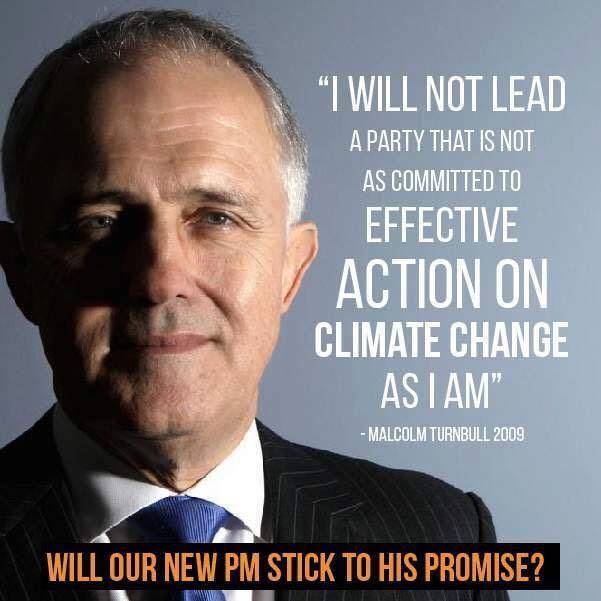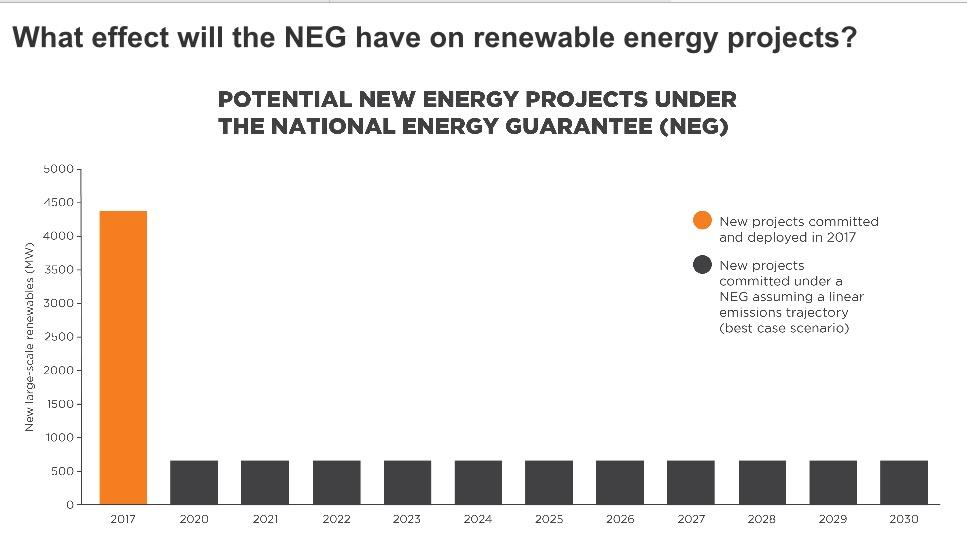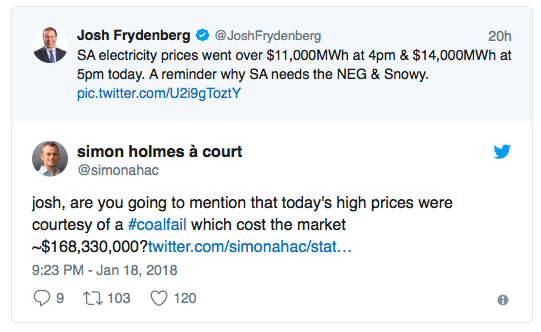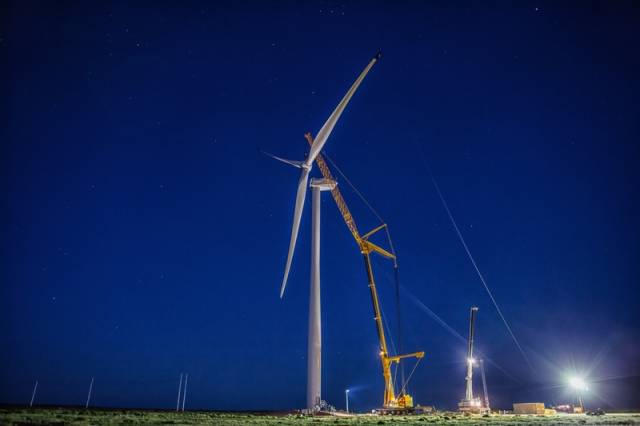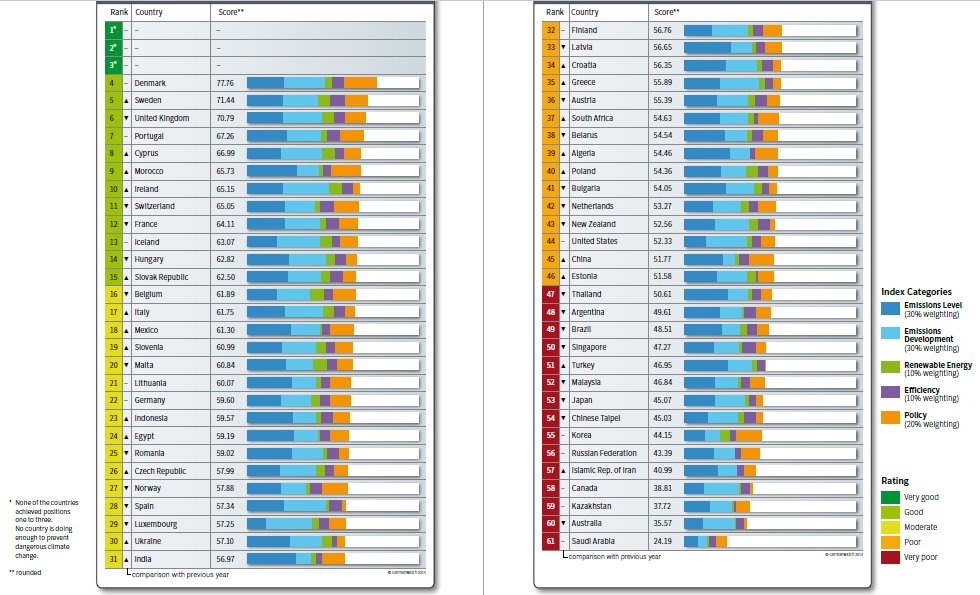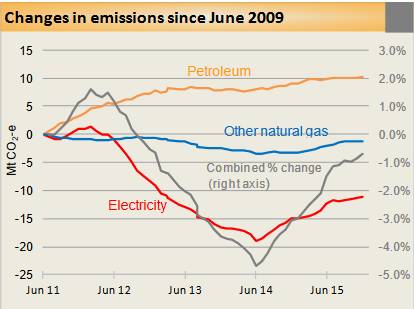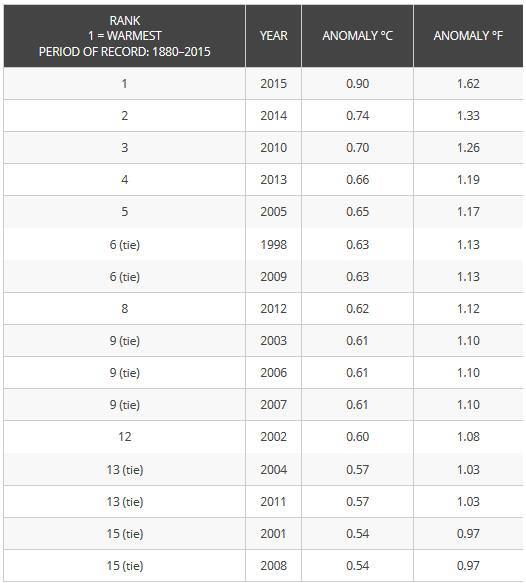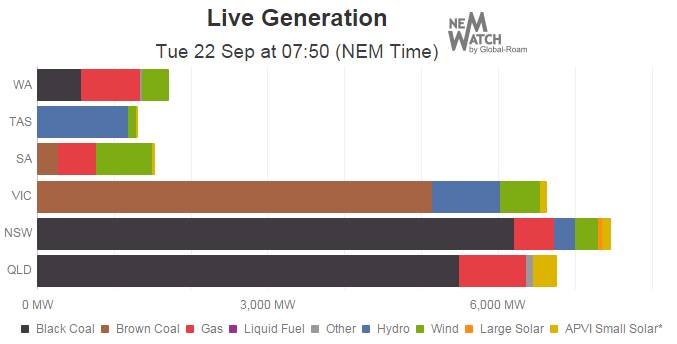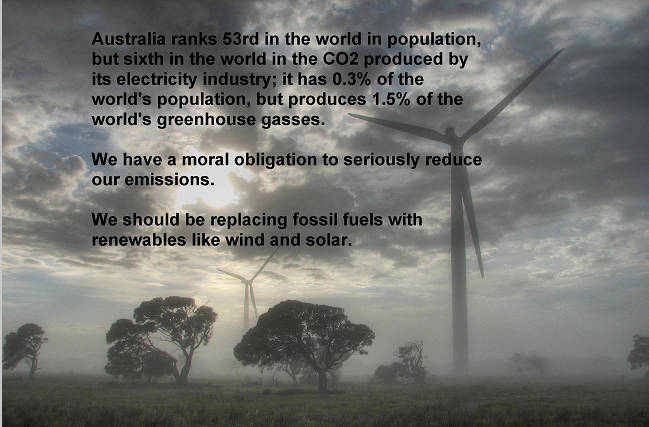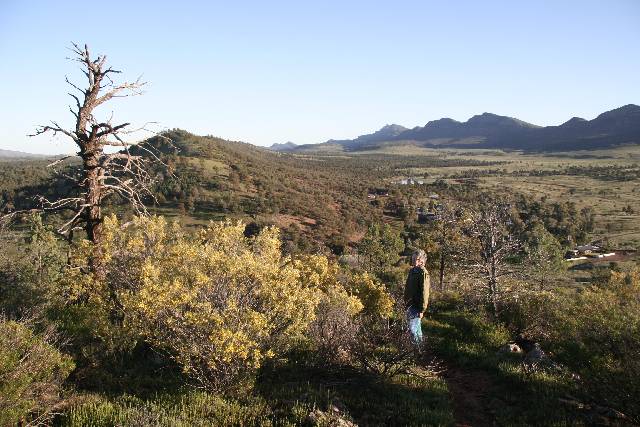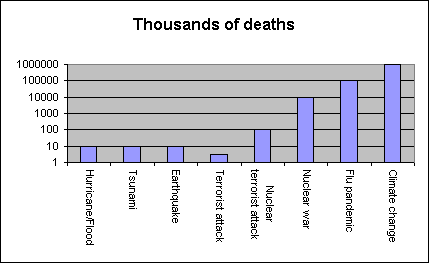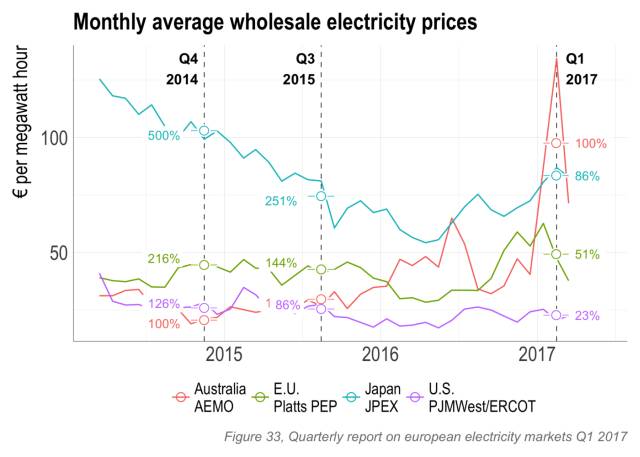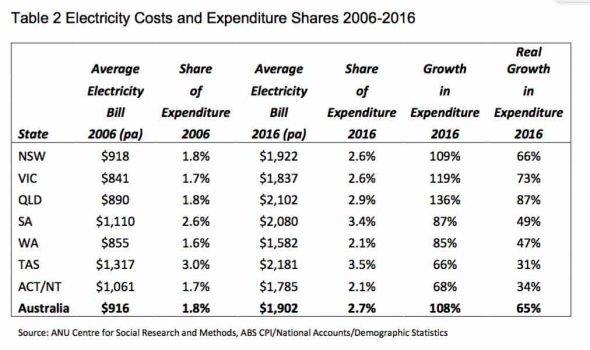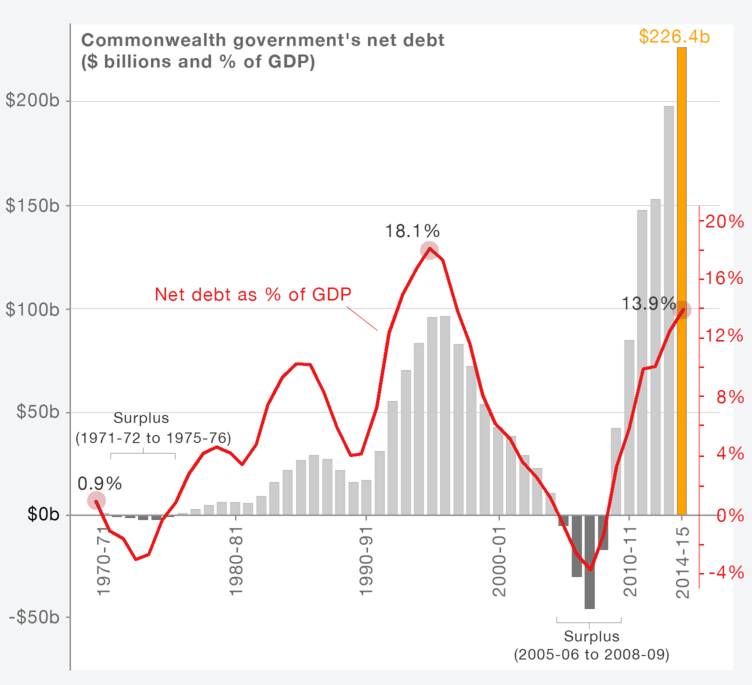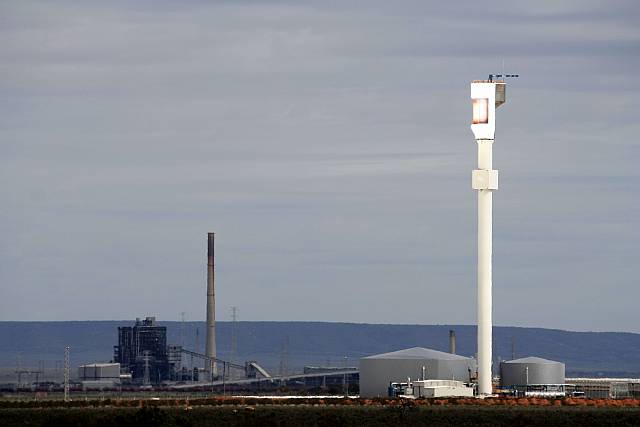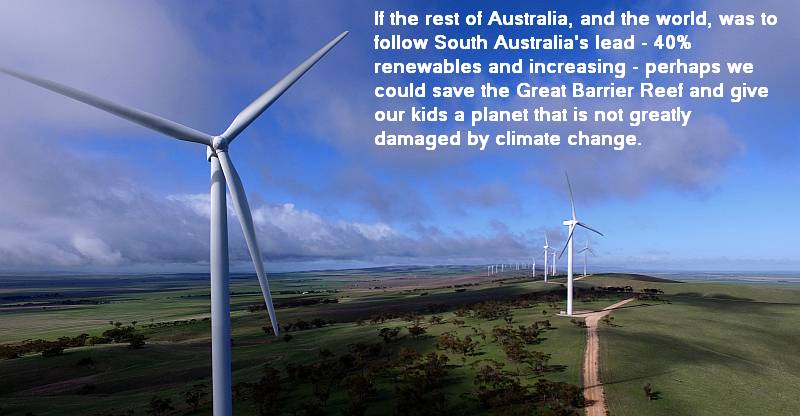Before the Abbott Government Australia had a wind energy industry, it wasn't
developing as quickly as it needed to in order to do our share in limiting
climate change, but it was developing.
PM Abbott did all he could to slow renewable energy development in general
and to put a stop to further wind farms in particular.
As shown in the image on the right, Malcolm Turnbull has said things that
indicate he is serious about climate change action, but his lack of action,
indeed, his blatant opposition to action on climate change since becoming
Australia's Prime Minister suggest that he has put ambition before scruples.
Malcolm Turnbull in August 2010
"We are as humans conducting a massive science experiment with this planet.
It's the only planet we've got...
We know that the consequences of unchecked global warming would be
catastrophic.
We know that extreme weather events are occurring with greater and greater
frequency and while it is never possible to point to one drought or one
storm or one flood and say that particular incident is caused by global
warming, we know that these trends are entirely consistent with the climate
change forecasts with the climate models that the scientists are relying on...
We as a human species have a deep and abiding obligation to this planet and
to the generations that will come after us."
The Guardian
| |
|
This section added 2018/07/15
|
|
| |
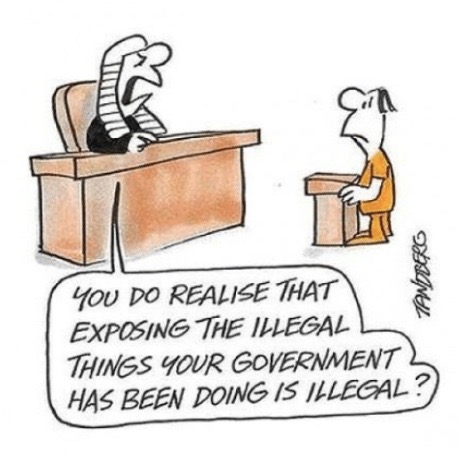
| | Cartoon credit: Ron Tandberg
| |
Australia, under Foreign Minister Alexander Downer, illegally bugged the East Timorese embassy and used the information so obtained to cheat the Timorese people out of their rightful share of the oil and gas resources of the Timor Sea.
This was bad enough, but in July 2018 the man who 'blew the whistle' on Australia's illegal (and very unethical) behaviour was being tried for treason.
John Menadue published Senator Andrew Wilkie's
coverage of this matter in a speech in the Australian Senate on 2018/07/02.
(I believe it is illegal to use the victim's name at the time of writing.)
The whistle-blower deserves a medal rather than a jail term for his action, it is Alexander Downer who should be jailed.
| |
|
This section added 2018/06/26
|
|
The graph on the right is how the
Clean Energy Council sees the impact of the Turnbull Government's Clean Energy Guarantee.
The orange bar on the graph shows the renewable energy committed or deployed in 2017, the black bars show the pathetic target for the remaining years to 2030. If the Turnbull Government's aspirations for emissions reductions were any lower they'd be invisible.
Fortunately, as I understand it, the NEG mandates only a minimum level of renewable energy development.
Actual renewable energy development will most likely be very much higher than the government's pathetic target.
On present indications, while the government does all it can to slow the adoption of renewable energy in Australia, as demonstrated by the NEG, it seems that they will be overtaken by developments.
Australia's coal fired power stations are ageing and will have to be progressively shut down; at the same time renewable energy options are becoming cheaper.
In a nation with Australia's renewable energy resources, new-build coal fired power stations are not economically competitive with wind or solar PV (and nuclear is even less competitive).
All the indications are that renewables will go from strength to strength in the future.
| |
| Hazelwood coal mine fire, Latrobe Valley, Victoria, February 2014
|
|---|
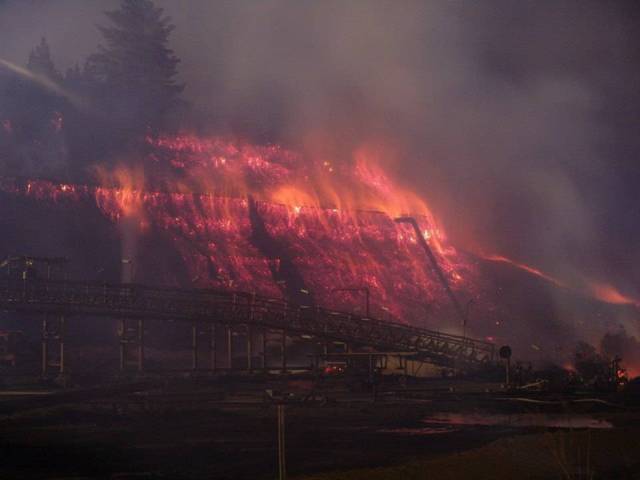
| | Image credit 350.org
| |
At a time when it should be obvious to all that the coal industry, especially the thermal coal industry,
has no future our Prime Minister has announced a
$500 million pilot plant proposal to turn
160 tonnes of Latrobe Valley brown coal into
three tonnes of hydrogen.
That's not three tonnes a day, it's three tonnes over the life of the plant!
Are there better alternatives?
Yes, far better; for example, the
Crystal Brook Energy Park, if built, is expected to produce 20 tonnes of hydrogen a day – from clean wind and solar power!
A hydrogen electrolyser announced for Port Lincoln is expected to produce 10 tonnes of hydrogen a day, again using renewable energy, and
the entire plant has been costed at $118 million.
(I have written about renewable-energy-to-hydrogen developments in Australia
elsewhere on these pages.)
The coal project, on the other hand, would normally be expected to put many tonnes of
climate changing and
ocean acidifying carbon dioxide into the atmosphere for each tonne of hydrogen produced.
Economic viability
The economic viability of any full-scale brown coal to hydrogen project is highly questionable.
To make the proposal mysterious to the point of weirdness, the developers recognise that a
carbon capture and storage (CCS) system for the emissions would be critical to the commercialisation of the technology.
CCS would greatly increase the cost of the process; most places it has been tried it has a record of failing because of its lack of economic viability.
Combining CCS with a process that is of questionable economic viability in the first place would condemn it to failure.
Environmental implications
The carbon content of the Loy Yang coal that will be used is around 72 to 83 percent
(The Chemical Characteristics of Victorian Brown Coal).
Working on 77% carbon content we can calculate that 160 tonnes of coal contains 123 tonnes of carbon.
When burned this will combine with 328 tonnes of oxygen to produce 450 tonnes of carbon dioxide;
that is 450 tonnes of greenhouse carbon dioxide to produce three tonnes of hydrogen.
Is it believable that it will be economically viable to capture and store indefinitely, 450 tonnes of carbon dioxide for every three tonnes of hydrogen this mad-cap project is expected to produce?
It certainly would be criminal to release the CO
2 into the atmosphere.
Time to productive completion
According to the project documents, the decision to proceed to commercial phase will be made in the 2020s with operations targeted in the 2030s; so something more than 22 years for it to produce commercial quantities of hydrogen.
The Crystal Brook Energy Park and the Port Lincoln electrolyser could be up and running long before that.
Who is going to pay
The Turnbull Government has promised $50m and the (Labor) Victorian Government has promised another $50m for the coal-to-hydrogen project.
The remaining $400m is apparently to come from a Japanese consortium – led by Kawasaki Heavy Industries (KHI) – and the Japanese Government.
This is a pilot plant, so no-one would be expecting it to make a profit.
I cannot imagine why they would want to touch such a hair-brained scheme without promises of huge subsidies.
Most likely achievements
The only thing we can be sure of with this project is that there will be many millions of taxpayers' dollars going up in smoke.
And if the carbon dioxide is not captured and stored we can expect 150 tonnes of CO
2 to be released into the atmosphere for every tonne of hydrogen produced.
Why hydrogen anyway?
The great advantage of hydrogen as a fuel is that when it is burned only steam is produced; most other fuels release carbon dioxide.
If the hydrogen is produced from renewably generated electricity, as is proposed in several projects in Australia and elsewhere, this makes sense.
To burn coal to produce hydrogen makes the whole thing absurd!
|
More information on hydrogen – Links
For the details of PM Turnbull's last ditch stand to prop-up Victoria's doomed brown coal industry see
RenewEconomy.
The Conversation; Explainer: how do we make hydrogen from coal, and is it really a clean fuel?
Carbon Commentary; 2017/07/05, Chris Goodall; "Hydrogen made by the electrolysis of water is now cost-competitive and gives us another building block for the low-carbon economy".
PM Turnbull's
press release
For shear stupidity this project even eclipses
Tony Abbott's 'Monash Forum'.
| |
| The Hornsdale Tesla big battery
|
|---|
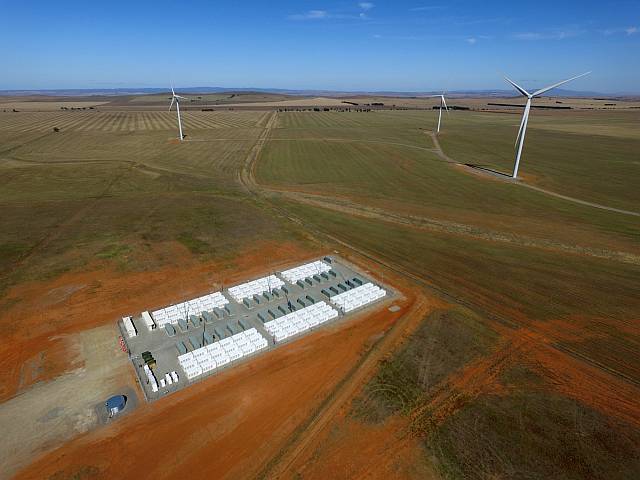
| |
The Hornsdale Power Reserve received a lot of publicity in mid 2017 when Elon Musk accepted a challenge to build it in South Australia in 100 days or do it for free.
It has a maximum power output of 100 MW and an energy storage capacity of 129 MWh, it was built in well under the promised 100 days and it has been a huge success.
In an
article written by Sophie Vorrath and Giles Parkinson in RenewEconomy titled "The stunning numbers behind success of Tesla big battery" and published on 2018/05/11 it was reported that:
"The Tesla big battery in South Australia has already taken a 55 per cent share in the state’s frequency and ancillary services market, and lowered prices in that market by 90 per cent, new data has shown.
Various estimates have put the cost savings to consumers from the FCAS market alone at around $35 million, just in the first four months of its operation.
That’s a pretty good bang for the buck for the estimated $50 million investment by the South Australia government. South Australia is the only state that has experienced a decline in FCAS prices over the past few months."
When the Tesla battery was proposed Federal (Liberal) Treasurer Scott Morrison was reported in
The Daily Telegraph as having said that Mr Musk’s bid to build the world’s largest lithium ion battery wouldn’t solve any energy problems because its capacity is so small.
He said:
“By all means, have the world’s biggest battery, have the world’s biggest banana, have the world’s biggest prawn like we have on the roadside around the country, but that is not solving the problem,”
Morrison said Tesla boss Mr Musk was clearly very good at promotion. “I think he saw [South Australian Labor Premier] Jay Weatherill coming.”
For a Federal Treasurer to be so greatly in error in an important financial matter is quite shocking.
PM Turnbull, can you think of any reason that you shouldn't be given a D minus on your performance as PM?
| |
Dishonest opposition to renewable energy
Climate change is a huge looming disaster; no well informed open minded person can doubt this.
The burning of coal produces air pollution that
kills millions of people each year.
I have argued elsewhere that for a person in a position of power to dishonestly support fossil fuels and disparage renewable energy is perhaps the
greatest crime in the history of humanity.
PM Turnbull is one such person.
|
|
In 2009 you said “I will not lead a party that is not as committed to effective action on climate change as I am”. Instead you have led a government that has been obsessed with coal and implacably opposed to renewable energy.
You have let down the Australian people, who want action on climate change and are strongly in favour of renewable energy.
You have even failed your own right wing, who seem to provide you with your instructions.
Renewable energy has gone ahead in leaps and bounds, despite your (and their) best efforts to stop it; at the time of writing there were nearly 3GW of wind farms under construction in Australia, far more than at any other time; it’s the first time ever that at least one wind farm has been under construction in every Australian state. And, of course, there’s a huge amount of solar power being developed, and energy storage too.
I've listed the wind farms under construction in Australia
elsewhere on this net site.
South Australia's success in its adoption of renewable energy in the face of strong opposition from the Turnbull Government is described on another page.
Some of the more notable renewable energy developments in Australia are listed
here.
| |
|
This section added 2018/05/01
|
|
The Turnbull government resisted the holding of a royal commission on the banking industry for as long as possible.
In the end they were forced to allow it by a combination of Labor, the Greens, independents, and the Nationals.
The royal commission has
exposed a huge range of illegal and unethical conduct by the banks and insurance industry.
Why was the Turnbull government so strongly opposed to it?
You'd have to wonder if it was the greedy and wealthy looking after their own interests at the expense of the rest of us.
| |
|
This sentence was written 2018/11/29
|
|
Looking back on the time of the Turnbull government in late 2018 I would have to say that in my opinion PM Turnbull's resistance to the holding of a banking royal commission would be his most shameful act other than his failure to act on climate change.
| |
| A big screen reminds people in Beijing of what a blue sky looks like
|
|---|
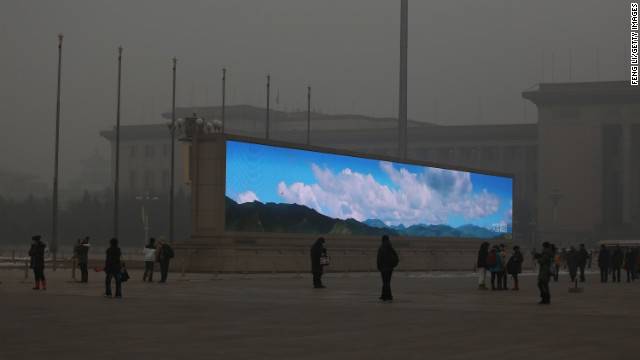
| Air pollution, much of which comes from burning coal, kills millions of people each year.
Image source: FengLi/Getty Images
|
|
|
|
|
| This wind farm produces electricity without air pollution.
|
|---|
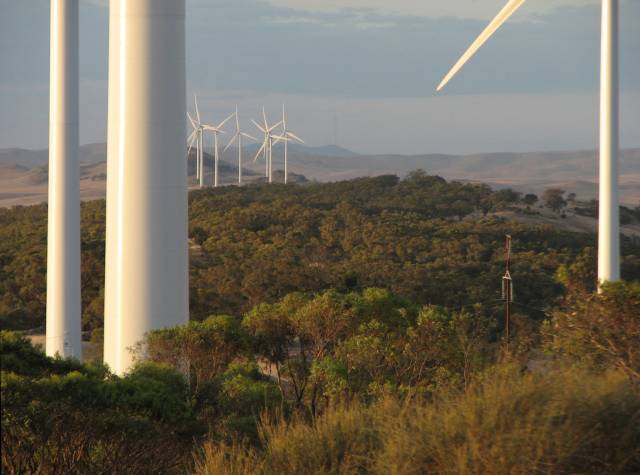
| Waterloo
Wind Farm,
Mid North South Australia.
Australia could follow a moral course, boost its renewable energy industries and cut back on its industries that kill people and damage the planet.
| |
In late January 2018 PM Turnbull
stated an aim to spend billions of dollars on boosting the Australian arms industry.
He wants Australia to become one of the world's top 10 exporters of weapons within a decade.
The Turnbull government has continued the policy of previous Coalition governments in strongly supported the coal industry while trying to slow renewable energy development.
The fact that air pollution from the burning of coal
kills millions of people each year seems not to bother them, nor does the
climate change damage from the burning of fossil fuels.
It seems the coal industry is not causing enough killing for the Turnbull government, he wants Australia to manufacture and export machines and devices that are more directly aimed at killing people.
There are far more
ethical industries in which Australia could be involved, renewable energy is just one example.
Australia has huge renewable energy
resources waiting to be developed, huge potential to become a world renewable energy leader, and huge potential to export renewable energy and renewable energy technology.
Australia could be an example of a country that does good in the world, rather than a country this is big on
exporting death.
What unethical industry will PM Turnbull propose next?
Australia could produce and export heroin, ice, cocaine, etc. – there is big money there too, and it's probably no more unethical than weapons and coal? Does that appeal PM Turnbull?
| |
|
This section added 2018/05/22
|
|
While the Turnbull Government tries desperately to get a bit more life out of the dying coal industry Australia is missing out on a great opportunity.
In May 2018 "a new report from Bloomberg New Energy Finance forecast that demand for copper, high-purity nickel, cobalt and lithium used in the manufacture of EV battery packs was forecast to rise 31 times, 42 times, 19 times and 29 times respectively to 2030, as sales of EVs [electric vehicles] soar to 30 million by 2030."
Sophie Vorrath wrote a summary for
RenewEconomy on 2018/05/22.
"At current commodity prices, BNEF says, the supply of these materials for batteries would be worth $US75 billion in the year 2030."
What wasn't mentioned in the RenewEconomy article was the fast-growing market for home batteries and utility-scale batteries.
These may well prove to be a greater growth industry than EV batteries.
First one, 2018/01/18
Energy Minister Josh Frydenberg doesn't miss a chance to blame any problem in the electricity supply on South Australia's renewable energy.
On 2018/01/18 he blamed SA for exceptionally high wholesale electricity prices that were actually due to a big coal-fired power station in Victoria failing.
Sophie Vorrath wrote an
article for RenewEconomy giving the real reason for the wholesale electricity price spike: the sudden failure of one of the generation units at Victoria's Loy Yang B power station.
Wholesale prices went to over $10,000/MWh in both Victoria and SA.
The cause seems to have been the heatwave conditions; quoting from Ms Vorrath's article:
"The sudden outage of the Loy Yang B unit is the 13th failure of a major coal unit this summer."
"Thursday’s unexplained outage of Loy Yang B caused the near instant loss of 530MW of capacity, and sent prices soaring in Victoria (to more than $12,900MWh) and South Australia, to a peak of $14,600/MWh."
Of course no minister of the Turnbull Government would ever say a critical word about a coal-fired power station.
Second one, 2018/01/22
Simon Holmes à Court
picked up this one too and wrote about it on RenewEconomy.
Josh Frydenberg, Australia's federal Minister for Environment and Energy, continued to attempt to rubbish South Australia in an interview broadcast on the ABC's Radio National.
On the interview, in which he attempted very unconvincingly to deny Australia's increasing greenhouse emissions, Mr Frydenberg said that SA burns "80,000 litres of diesel an hour, just to keep the lights on".
It seems that if all SA's new diesel generators, designed and used for emergencies only, were to run for an hour at full tilt, they would burn 80,000 litres of diesel.
According to Mr Holmes à Court the generators have burnt less that 40 tonnes (about 45,000 litres) of diesel in total to the present.
By way of comparison, the Port Augusta power stations, the closing of which Mr Frydenberg has strongly criticised, burnt 67 tonnes of brown coal every hour.
Unlike the emergency diesel generators, the bigger of the two coal-fired power stations, the Northern, used to run continually for months at a time.
Mr Frydenberg hates renewable energy, but he seems to hate South Australia even more, presumably because of SA's
highly successful adoption of renewables.
| |
Written 2017/06/12,
Added to 2017/07/08
|
|
| |
Coal kills far more people than terrorists do
PM Turnbull, your government is concerned about terrorism – terrorists
kill about 20,000 people each year.
Your government supports the coal industry big time – its air pollution
kills millions of people each year.
Your government opposes wind power – wind turbines don't kill anyone.
Does this make any sense?
Terrorism and
coal
Wind turbines save
lives
Killer coal
|
|
PM Turnbull has made statements roundly condemning the recent terrorist
bombing in Manchester.
At the same time he is doing his best to slow the take-up of renewable energy
in Australia and to support the
dying coal industry.
The burning of
coal kills hundreds of thousands, quite
probably millions, of people each year from its air pollution.
It is also one of the main causes of the
climate change and
ocean acidification
that will probably kill millions, possibly billions of people
and result in the extinction of many thousands of species in the next fifty
years or so.
PM Turnbull's condemnation of a terrorist who was responsible for the death
of some 22 people in Manchester is the grossest hypocrisy when he is involved
in
actions
that will bring about the deaths of enormously more people and do
incomparably more harm.
More Hypocrisy, July 2017
Josh Frydenberg, the Turnbull Government's Minister for Environment and
Energy, said that while emissions have been rising – as shown in
figures that he had just been forced to release – he was confident
that Australia would achieve its emissions targets because "there is a
rapid transition taking place" in our energy generation system.
(The rapid transition being the building of many wind farms and
utility-scale solar power stations.)
What Mr Frydenberg did not say was that the transition was taking place in
spite of the COALition's best efforts to stop it.
| |
|
This section added 2018/05/21
|
|
On 2018/05/17 The Senate Committee on Foreign Affairs, Defence and Trade presented its report on the national security implications of climate change.
The report was summarised in
The Conversation by Matt McDonald, Associate Professor of International Relations, The University of Queensland.
The Turnbull government has continued the harsh treatment of refugees that was put in place by previous governments.
At the same time they have done their best to slow Australia's change from fossil fuels to renewable energy and, as the Senate Committee recognised, climate change will greatly increase the numbers of refugees.
The Turnbull government's support for the fossil fuel industry and opposition to the renewable energy industry is exacerbating climate change and so leading to a long term increase in security threats.
This is another form of
hypocrisy, on the one hand the Turnbull government justified setting up the Australian Border Force on the grounds that there was a major threat from people trying to get into the country and at the same time it is taking actions that will increase that threat.
| |
|
This section added 2017/05/01
|
|
| |
Why are the banks turning their backs on the Carmichael Mine?
We would like to see banks refusing to fund unethical projects for ethical
grounds, but I strongly suspect that this is all to do with financial
considerations.
The banks recognise that
coal has no future, that it is simply a bad
investment.
They would lose their money if the mine was forced to close after only five
or ten years, as is likely to happen as the seriousness of the need for
climate change action becomes more obvious.
|
|
In late April 2017 Westpac, one of Australia's 'big four' banks, has launched
its
updated Climate Change Action Plan.
The Action Plan included these points, among others:
- $10 billion target for lending to climate change solutions by 2020 and
$25 billion by 2030.
- Tighter criteria for financing any new coal mines.
Financing for any new thermal coal projects limited to existing coal
producing basins and where the calorific value of coal meets the energy
content of at least 6,300kCal/kg Gross as Received – i.e. projects must
rank in the top 15% globally.
- Commitment to actively reduce the emissions intensity of the power
generation sector, targeting 0.30 tCO2e/MWh by 2020.
- Continued commitment to a broad market-based price on carbon as the most
efficient way to.
The second point was of particular relevance to the situation at
the time.
The Indian Company Adani had a very controversial proposal to open a huge
coal mine (Carmichael Mine) in Queensland's Galilee Basin, which had not
been previously mined.
Adani told the Queensland land court in 2014 that the Carmichael coal would
only have 4,950kCal/kg,
so the mine fails to meat Westpac's criteria on two grounds.
According to
The Guardian all of Australia's big four banks have now ruled out
funding, or withdrawn support from, the Carmichael Mine.
Quoting The Guardian:
"NAB ruled out funding the Carmichael project in September 2015, a month
after Commonwealth Bank parted ways with Adani as project finance adviser.
The CEO of ANZ, Shayne Elliott, in effect ruled out financing the mine last
December when he predicted a downward shift in the bank's exposure to
coalmining would continue for the foreseeable future."
Westpac's forth point shows yet again that Australia needs a price on carbon;
something that the Turnbull Government has consistently, and pig-headedly,
refused to countenance.
RenewEconomy
reported, 2017/05/02, that 15 other banks around the world had also refused to fund the mine.
| |
|
This section added 2017/03/11
|
|
| |
| A part of Boco Rock Wind Farm, NSW
|
|---|
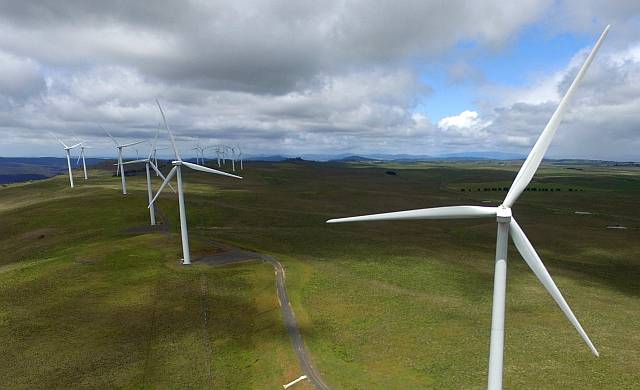
| The installed capacity of Boco Rock WF is 113 MW; it will
probably generate around 350 GWh per year.
Photo taken 2016/11/14
| |
In March 2017 the Australian Energy Market Operator published a
Gas Statement of Opportunities.
The first Key point in the Executive Summary stated:
"Declining gas production may result in insufficient gas to meet projected
demand by GPG [gas powered generation] for supply of electricity from summer
2018-19.
– To meet electricity supply needs, the NEM [National Electricity
Market] requires either increases
in gas production to fuel GPG, or a rapid implementation of alternative
non-gas electricity generation sources.
If neither occurs, AEMO projects that declining gas supplies could result in
electricity supply shortfalls between 2019 and 2021 of approximately 80
gigawatt hours (GWh) to 363 GWh across South Australia, New South Wales,
and Victoria."
In recent years the total annual electricity consumption on the National
Electricity Market has been around 200 TWh per year, so the projected
363 GWh short-fall is only 0.18% of that total.
Renewable energy systems, especially wind and solar, could and should be built
at greater rates than at present.
However, gas fired electricity is valuable for keeping generation up to the
peaks in electricity demand; some types of gas-fired power stations are well
suited to providing power exactly when it is needed, wind and solar PV cannot
do that (although solar thermal with storage can).
Demand for gas could be reduced in several ways:
- Solar thermal power with energy storage could be developed, it is well
developed in the USA and Spain;
- Incentives could be given for household battery systems and electric
vehicle batteries to be linked to the grid and to supply power in periods of
exceptional demand;
- Existing hydro power could be reserved as far as possible for generating in
peak consumption periods, reducing the need for gas peaking power plants;
- Batteries or new pumped hydro systems could be used to store electricity
when it is abundant so that they could then feed it back into the grid
during peak demand;
- The gas that is not required because of new generation from renewables
could be stored in Victoria's Iona underground gas storage for later use in
periods of high demand;
- Those who use gas for home and water heating could be given incentives to
change to electricity instead.
Electric heat-pumps (such as reverse-cycle air conditioners) are a more
energy-efficient way of heating than gas;
- It is in winter when electricity demand is highest in Victoria, for
home and water heating; winds tend to be strongest and most consistant in
winter, so wind power would be well suited to at least partly take the place
of gas in that state.
| |
|
This section added 2017/02/10
|
|
South Australia has gone from very little renewable power in 2003 to around
40% in 2017.
The South Australian government has a target of 50% renewbles by 2020.
PM Turnbull has said that this, going from zero to 50% in 17 years is
dangerously rash.
Coober Pedy is a small town 750 km north of Adelaide.
It is not connected to the eastern Australia National Electricity Market
(NEM) grid.
The town has had a small, 0.15 MW,
wind turbine since 1991, but has
relied mostly on very expensive diesel-powered generators for its electrical
supply.
In 2017 the town was adding two 2 MW wind turbines, 2 MW of solar
PV and batteries.
They are going from near 100% diesel-generated power to 50% renewables
in a matter of a few months!
PM Turnbull, if the SA government is rash, what are the people of Coober Pedy?!
| |
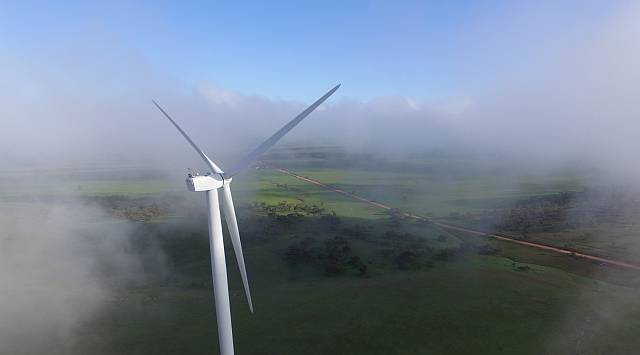
| | Clements Gap Wind Farm
| |
| |
Update 2017/02/16
The ABC reported that three times as many homes had their power cut than were
needed.
|
|
On the afternoon of the first day of a heatwave 90,000 South
Australian homes had their power cut off for periods of a half to
three-quarters of an hour.
This was done by the Australian Energy Market Operator (AEMO) because there
was a very high demand for power and a shortage in generation.
PM Turnbull blamed the 'load-shedding' on our renewable energy.
This was quite dishonest.
The low winds were forecast, the low level of wind power was expected, the
high demand for power to run air-conditioners was expected.
There was ample generation available had Pelican Point No. 2 gas-fired power
station been called in; it was not.
This was a simple case of poor management by AEMO.
Further, the SA state government has little direct control over the day-to-day
running of our power
supply since Liberal Premier John Olsen privatised our electricity supply
– after promising not to before the election that put him into power.
AEMO reports to the Federal Energy Minister, so if any politician needs to
take responsibility for the load-shedding it would seem to be he.
PM Turnbull has simply and quite dishonestly used this event to further the
interests of the coal industry that is one of the main drivers of
climate change and
ocean acidification
and is responsible for
millions of deaths around the world every
year from its air pollution.
Load-shedding in NSW, same heatwave, next day, 2017/02/10
| |
Coal fails in NSW, wind and solar to the rescew
Renew Economy reported on 2017/02/13 that two 500 MW units of the coal-burning Liddell power station were out of action during the heatwave because of boiler tube leaks.
On the other hand, NSW Energy Minister Don Harwin said "It's the biggest day
ever for solar" and that there was "plenty of wind power generation coming
from the wind turbines along the Great Dividing Range".
|
|
As reported by the
ABC the Tomago aluminium smelter, which normally consumes 10% of NSW's
electricity, curtailed its power consumption to avoid the necessity of
load-shedding elsewhere in the state.
A power outage affecting 11,000 customers in the Sydney suburbs of Burwood and
Strathfield at around the time of peak electricity demand (around 4pm) was not
caused by load-shedding, but would have reduced power demand at a critical
time.
South Australia didn't have an aluminium smelter that could curtail its
power consumption the day before.
PM Turnbull, is there any significant difference between this event, in mainly
coal-powered NSW, and the event the day before, in more renewables-powered SA?
| |
|
This section added 2017/02/05
|
|
| |
| Mugga Lane Solar Farm
|
|---|
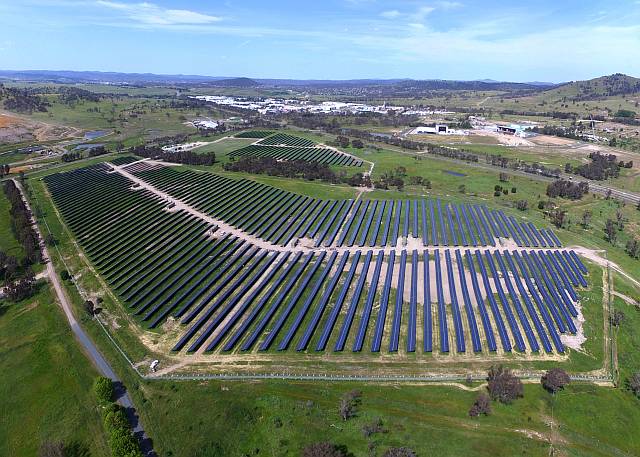
| | One of the solar farms recently built in the Australian Capital
Territory – photo November 2016
| |
In early 2017 both Prime Minister
Turnbull and Deputy Prime Minister
(and head of the Australian Nationals) Barnaby Joice made statements
favourable to subsidising and building new coal-fired power stations in
Australia.
These are not needed and not wanted by most of the Australian people;
both large-scale solar and
wind power are expanding and there is
little increase in electricity demand from the grid.
The continuing installation of solar power on the roofs of Australian homes as
well as the increasing number of utility-scale solar power stations (like the
one in the photo on the right) is also
reducing demand for new fossil fuel power.
The Coalition are proposing heavily subsidising new coal-fired power stations
because banks and investment funds will not support them – simply
because they are a very bad investment.
As Frank Jotzo, Director, Centre for Climate Economics and Policy, Australian
National University,
wrote in The Coversation,
"New coal plants
wouldn't be clean, and would cost billions in taxpayer subsidies".
"Major Australian energy companies have ruled out building new coal plants.
The Australian Energy Council sees them as "uninvestable".
Banks and investment funds would not touch them with a barge pole.
Only government subsidies could do it."
How absurd and unethical it would be for the Australian government to
heavily subsidise the building of more coal-fired power stations for this
killer industry when they are not even
economically viable?
| |
| Map of the Great Barrier Reef showing results of aerial surveys for
911 reefs
|
|---|
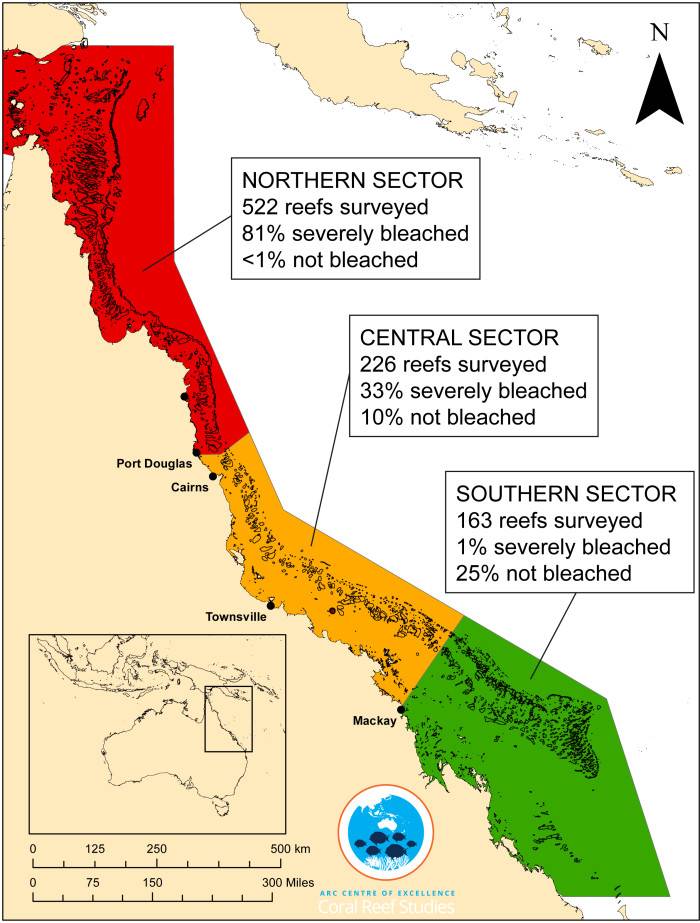
| Image credit ARC Centre of Excellence, Coral Reef Studies
Media release dated April 2016
| |
First, in March 2016, there was the
worst bleaching event on record for the
Great Barrier Reef, then just in the last few days, we heard that there was a
large scale die-back of mangroves along
hundreds of kilometres of the south coast of the Gulf of Carpentaria and that a
marine heatwave has wiped out kelp forests
along a 100km of WA's coast.
In August and September of 2017 there was climate change linked
devestation in southern Asia and North
America: record monsoonal flooding in India, Nepal and Bangladesh, record
flooding from Hurricane Harvey in Texas, unprecedented wildfires in Canada
and the north-western USA.
At the time of writing, another hurricane, Irma was leaving a wake of
destruction on its way to Florida.
What was the
Turnbull Government doing?
Still considering giving a billion dollars of taxpayers' money to Adani to open a new coal mine, pushing for keeping the Liddell coal-fired power station open five years more than its owner, AGL, intended. And at the same time criticising the SA Government's
great success in going from fossil fuelled to renewable electricity as
"ideology and idiocy in equal measures". (See articles by the
ABC and the
Huffington Post.)
How many more disasters like this will it take for you and your government
to state taking serious action over climate change PM Turnbull?
| |
|
This section added 2016/12/05
|
|
In early December 2016 PM Turnbull announced that he would seriously consider
a
lone of $1b of Australia's tax-payers' money to help Adani build a railway
line so that he could mine and ship coal from the Galilee Basin through the
Great Barrier Reef (GBR).
| |
Not financially viable
Adani has been unable to get finance for building the railway line from the
normal sources because it is very unlikely that the Carmichael mine will
ever be financially viable; the banks don't want to know about it.
Indian Energy Minister Piyush Goyal has repeatedly stated he plans to end
virtually all thermal coal imports into India by the end of the decade.
Adani is also into solar, but Turnbull can't see past coal
In early December 2016 Adani commissioned the biggest single-location solar
PV power
installation in the world, 648MW in his homeland, India.
|
|
This will produce a multiplicity of new threats to the reef that is already
suffering heavy damage from both pollution and global warming.
Another port on the GBR coast will result in silting of the reef.
The many ships that go into and out of the port will add to pollution and
there will be accidents, spillages of fuel and groundings.
Finally, of course, the last thing this planet needs is another coal mine
to add to the greenhouse emissions that are the main cause of disastrous
climate change.
The context of the map on the right can be seen on
CoralCOE.
Also see
Great Barrier Reef
suffered worst bleaching on record in 2016, report finds, BBC.
| |
|
This section added 2016/10/04
|
|
How many times have climate scientists warned us that violent weather events
will become more common with the warming of the atmosphere?
South Australia suffered two such events – exceptional winds and rains
– in September 2016; the first on
14-15th and the second on 28-29th.
The second of these events, coming on top of already saturated soils, caused
flooding and the loss of grid-electricity over the whole of the state.
There are four major power transmission lines connecting Adelaide to the
north of the state; 22 or 23 power pylons on three of these were blown down.
We were told that the state's power system could have handled the loss of
two of the transmission lines, but three were too many; the system had to
shut down to avoid further damage.
(The saturated soil combined with high winds caused some of the pylon's legs
to pull out of the ground; others were simply bent over by the force of the
wind.)
What does this have to do with the Turnbull Government?
The Turnbull Government did its best to blame the power outage on SA's
high level of renewable energy!
True to form, they continue to mindlessly support the coal industry (one of
the main causes of climate change and the increasingly frequent violent
weather events) and denigrate renewable energy.
Blaming damage caused by burning coal on the renewable energy industry is
classic Orwellian political reasoning by a political party devoted to the
dying coal industry.
| |
|
This section added 2017/09/05
|
|
Devastating Hurricane Harvey has cost the USA more than $100 billion dollars
and 50 deaths while flooding in India, Nepal and Bangladesh has killed at
least 1200 and directly affected more than 40 million people.
Both disasters, if not directly ascribable to climate change were made much
more likely by climate change, so the need to change from the burning of
fossil fuels to renewable energy such as wind, solar PV, solar thermal, wave,
tidal and biofuels is shown to be even more urgent.
Yet the Turnbull Government is still opposing the change to renewable energy
and considering giving a billion dollars of taxpayers' money to shonky coal
mining company Adani so that they can increase the pollution of the
atmosphere we all share.
For more information, see
Climate Change Disasters.
Before becoming Prime Minister
Malcolm Turnbull went on record as supporting same-sex marriage,
supporting action on climate change and strongly supporting Australia
becoming a republic.
As of early February 2016 Mr Turnbull in his PM's hat seems to have betrayed
all of these ideals.
- He is supporting the unnecessary plebiscite on same-sex marriage, when
a number of polls have left no doubt that the majority of Australians want
same-sex marriage recognised in law.
The only reason for the plebiscite seems to be to delay changing the laws.
- Since becoming PM Mr Turnbull has done very little to increase the
amount of renewable energy in Australia and to reduce our greenhouse gas
emissions; the hiatus in wind farm construction engineered by PM Abbott
continues under PM Turnbull and it has just been reported that Australia's
emissions have increased for the first time since the Howard years.
- PM Turnbull has said that he still supports Australia becoming a republic,
but he seems to be opposing it happening in the near future.
PM Turnbull, ask yourself, are you really leading the Coalition, or are you
following their moribund and outdated policies?
Is holding onto the top job really worth the sacrifice of your ethical
standards?
Have you taken Tony Abbott's job, or have you just become a clone of Tony
Abbott?
Australia's greenhouse emissions have increased every year since the Liberal/National government was elected in 2013.
The Turnbull government wants to open the huge
Carmichael coal mine in Queensland's Galilee Basin, this will just make the situation worse.
